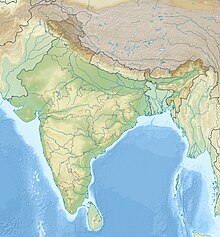நானாகாட்
| நானாகாட் குகைகள் மற்றும் கல்வெட்டுக்கள் नाणेघाट | |
|---|---|
 கிமு இரண்டாம் நூற்றாண்டின் நானாகாட்டின் குகைகள் மற்றும் கல்வெட்டுகள் | |
| மாற்றுப் பெயர் | நானாகாட் குகைகள் |
| இருப்பிடம் | ஜுன்னர் தாலுகா, புணே மாவட்டம், மகாராட்டிரா, இந்தியா |
| பகுதி | மேற்குத் தொடர் மலைகள் |
| ஆயத்தொலைகள் | 19°17′31.0″N 73°40′33.5″E / 19.291944°N 73.675972°E |
| வகை | குகைகள், கல்வெட்டுக்கள், வணிகப் பாதை |
| வரலாறு | |
| கட்டுநர் | சாதவாகனர் வம்ச இராணி நாகனிகா |
| கட்டுமானப்பொருள் | இயற்கைப் பாறை |
| கட்டப்பட்டது | கிமு இரண்டாம் நூற்றாண்டு |
| கலாச்சாரம் | இந்து சமயம் |
| மேலாண்மை | இந்தியத் தொல்லியல் ஆய்வகம் |
நானேகாட் அல்லது நானாகாட் (Naneghat, also referred to as Nanaghat or Nana Ghat (IAST: Nānāghaṭ), இந்தியாவின் மகாராட்டிரா மாநிலத்தில் அமைந்த புணே மாவட்டம், ஜுன்னர் தாலுகாவில் அமைந்த பண்டைய நகரம் ஆகும். மேலும் இங்குள்ள மேற்கு தொடர்ச்சி மலையில் ஒரு கணவாய் மற்றும் குகைகள் உள்ளது. இது புணே நகரத்திற்கு வடக்கே 120 கிலோ மீட்டர் தொலைவிலும், மும்பை நகரத்திற்கு கிழக்கே 120 கிலோ மீட்டர் தொலைவில் உள்ளது.
நானேகாட் குகைகள் கிமு இரண்டாம் நூற்றாண்டு காலத்திய சாதவாகனர் வம்ச இராணி நாகனிகா, பௌத்த பிக்குகளுக்காக நிறுவிய குடைவரைகள் உள்ளது. [1] இந்த நானாகாட் மலையில், கிமு இரண்டாம் நூற்றாண்டு முதல் கிபி முதலாம் நூற்றாண்டின் சாதவாகனர் காலத்திய பிராமி எழுத்துமுறைகளில் பொறிக்கப்பட்ட பாறைக் கல்வெட்டுக்களைக் கொண்டுள்ளது.[2] [3][4][5] இக்கல்வெட்டுக்கள் வேத கால தெய்வங்களின் பெயர்கள், சடங்குகள் மற்றும் சாதவாகன வம்ச மன்னர்களின் செய்திகள் கொண்டுள்ளது. [4][6] மேலும் நானாகாட் கல்வெட்டுக்கள் அக்காலத்திய எண்கள் கொண்டுள்ளது.[5][7][8]
இதனருகே 35 கிலோ மீட்டர் தொலைவில் புகழ்பெற்ற தேரவாத பௌத்தக் குடைவரைகளான லெண்யாத்திரி, கர்லா குகைகள் மற்றும் பாஜா குகைகள் உள்ளது.[9]
𑀭𑀸𑀬𑀸 𑀲𑀺𑀫𑀼𑀓 𑀲𑀸𑀢𑀯𑀸𑀳𑀦𑁄 𑀲𑀺𑀭𑀺𑀫𑀢𑁄
Rāyā Simuka - Sātavāhano sirimato
"King Simuka Satavahana, the illustrious one"[10]

இதனையும் காண்க
[தொகு]அடிக்குறிப்புகள்
[தொகு]மேற்கோள்கள்
[தொகு]- ↑ Georg Bühler 1883, ப. 53-54.
- ↑ Richard Salomon 1998, ப. 144.
- ↑ 4.0 4.1 Upinder Singh 2008, ப. 381-384.
- ↑ 5.0 5.1 Development Of Modern Numerals And Numeral Systems: The Hindu-Arabic system, Encyclopaedia Britannica, Quote: "The 1, 4, and 6 are found in the Ashoka inscriptions (3rd century bce); the 2, 4, 6, 7, and 9 appear in the Nana Ghat inscriptions about a century later; and the 2, 3, 4, 5, 6, 7, and 9 in the Nasik caves of the 1st or 2nd century CE — all in forms that have considerable resemblance to today’s, 2 and 3 being well-recognized cursive derivations from the ancient = and ≡."
- ↑ Carla Sinopoli 2001, ப. 168-169.
- ↑ David E. Smith 1978, ப. 65-68.
- ↑ Norton 2001, ப. 175-176.
- ↑ Vincent Lefèvre (2011). Portraiture in Early India: Between Transience and Eternity. BRILL Academic. pp. 33, 85–86. பன்னாட்டுத் தரப்புத்தக எண் 978-9004207356.
- ↑ Burgess, Jas (1883). Report on the Elura Cave temples and the Brahmanical and Jaina Caves in Western India.
ஆதார நூற்பட்டியல்
[தொகு]- Charles Allen (2017), "6", Coromandel: A Personal History of South India, Little Brown, பன்னாட்டுத் தரப்புத்தக எண் 978-1408705391
- Georg Bühler (1883), Report on the Elura cave temples and the Brahmanical and Jaina caves in western India (Chapter: The Nanaghat Inscriptions), Archaeological Survey of India,
 இந்தக் கட்டுரை பொது உரிமையில் உள்ள மூலத்திலிருந்து உரையைக் கொண்டுள்ளது.
இந்தக் கட்டுரை பொது உரிமையில் உள்ள மூலத்திலிருந்து உரையைக் கொண்டுள்ளது. - Theo Damsteegt (1978). Epigraphical Hybrid Sanskrit. Brill Academic.
{{cite book}}: Invalid|ref=harv(help) - Shobhana Gokhale (2004). "The Naneghat Inscription - A Masterpiece in Ancient Indian Records". The Adyar Library Bulletin 68-70.
- Mirashi, Vasudev Vishnu (1981), History and Inscriptions of the Satavahanas: The Western Kshatrapas, Maharashtra State Board for Literature and Culture
- Norton, James H. K. (2001). Global Studies: India and South Asia. McGraw-Hill. பன்னாட்டுத் தரப்புத்தக எண் 978-0-07-243298-5.
{{cite book}}: Invalid|ref=harv(help) - Richard Salomon (1998). Indian Epigraphy: A Guide to the Study of Inscriptions in Sanskrit, Prakrit, and the other Indo-Aryan Languages. Oxford University Press. பன்னாட்டுத் தரப்புத்தக எண் 978-0-19-535666-3.
{{cite book}}: Invalid|ref=harv(help) - Carla Sinopoli (2001). Susan E. Alcock (ed.). Empires: Perspectives from Archaeology and History. Cambridge University Press. பன்னாட்டுத் தரப்புத்தக எண் 978-0-521-77020-0.
{{cite book}}: Invalid|ref=harv(help) - Upinder Singh (2008). A History of Ancient and Early Medieval India: From the Stone Age to the 12th Century. Pearson Education. பன்னாட்டுத் தரப்புத்தக எண் 978-81-317-1120-0.
{{cite book}}: Invalid|ref=harv(help) - D.C. Sircar (1965), Select Inscriptions, Volume 1, University of Calcutta
- David E. Smith (1978). History of Mathematics. Courier. பன்னாட்டுத் தரப்புத்தக எண் 978-0-486-20430-7.
{{cite book}}: Invalid|ref=harv(help)
மேலும் படிக்க
[தொகு]- Alice Collet (2018). "Reimagining the Sātavāhana Queen Nāgaṇṇikā". Journal of the International Association of Buddhist Studies 41: 329–358. doi:10.2143/JIABS.41.0.3285746.




